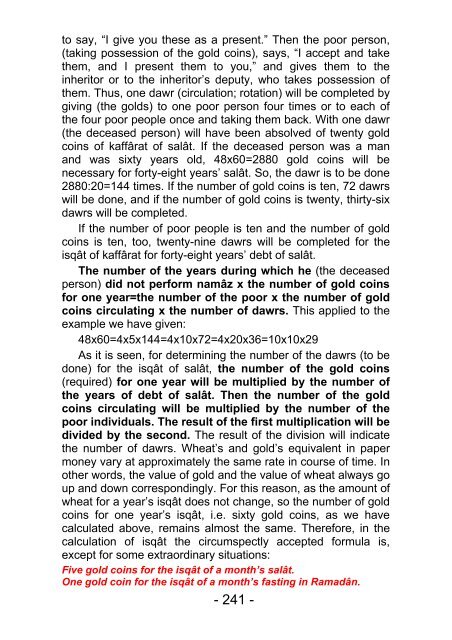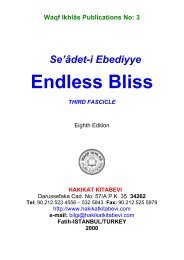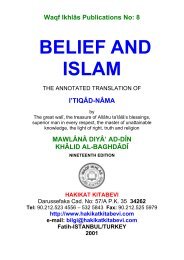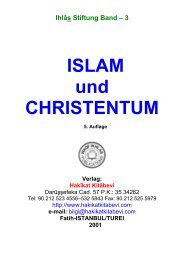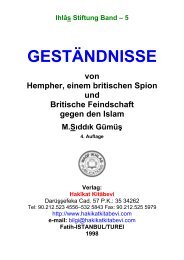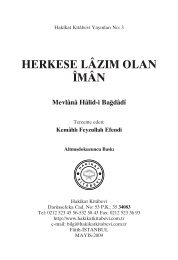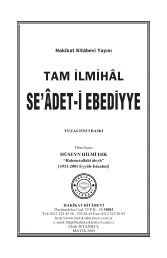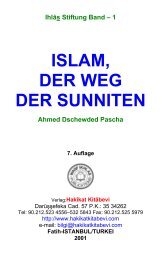5-Endless Bliss Fifth Fascicle - Hakikat Kitabevi
5-Endless Bliss Fifth Fascicle - Hakikat Kitabevi
5-Endless Bliss Fifth Fascicle - Hakikat Kitabevi
Create successful ePaper yourself
Turn your PDF publications into a flip-book with our unique Google optimized e-Paper software.
to say, “I give you these as a present.” Then the poor person,<br />
(taking possession of the gold coins), says, “I accept and take<br />
them, and I present them to you,” and gives them to the<br />
inheritor or to the inheritor’s deputy, who takes possession of<br />
them. Thus, one dawr (circulation; rotation) will be completed by<br />
giving (the golds) to one poor person four times or to each of<br />
the four poor people once and taking them back. With one dawr<br />
(the deceased person) will have been absolved of twenty gold<br />
coins of kaffârat of salât. If the deceased person was a man<br />
and was sixty years old, 48x60=2880 gold coins will be<br />
necessary for forty-eight years’ salât. So, the dawr is to be done<br />
2880:20=144 times. If the number of gold coins is ten, 72 dawrs<br />
will be done, and if the number of gold coins is twenty, thirty-six<br />
dawrs will be completed.<br />
If the number of poor people is ten and the number of gold<br />
coins is ten, too, twenty-nine dawrs will be completed for the<br />
isqât of kaffârat for forty-eight years’ debt of salât.<br />
The number of the years during which he (the deceased<br />
person) did not perform namâz x the number of gold coins<br />
for one year=the number of the poor x the number of gold<br />
coins circulating x the number of dawrs. This applied to the<br />
example we have given:<br />
48x60=4x5x144=4x10x72=4x20x36=10x10x29<br />
As it is seen, for determining the number of the dawrs (to be<br />
done) for the isqât of salât, the number of the gold coins<br />
(required) for one year will be multiplied by the number of<br />
the years of debt of salât. Then the number of the gold<br />
coins circulating will be multiplied by the number of the<br />
poor individuals. The result of the first multiplication will be<br />
divided by the second. The result of the division will indicate<br />
the number of dawrs. Wheat’s and gold’s equivalent in paper<br />
money vary at approximately the same rate in course of time. In<br />
other words, the value of gold and the value of wheat always go<br />
up and down correspondingly. For this reason, as the amount of<br />
wheat for a year’s isqât does not change, so the number of gold<br />
coins for one year’s isqât, i.e. sixty gold coins, as we have<br />
calculated above, remains almost the same. Therefore, in the<br />
calculation of isqât the circumspectly accepted formula is,<br />
except for some extraordinary situations:<br />
Five gold coins for the isqât of a month’s salât.<br />
One gold coin for the isqât of a month’s fasting in Ramadân.<br />
- 241 -


